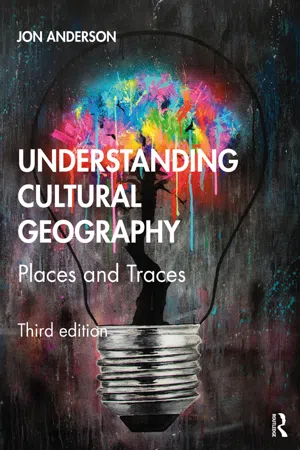
- 270 pages
- English
- ePUB (mobile friendly)
- Available on iOS & Android
About this book
This book outlines how the theoretical ideas, empirical foci, and methodological techniques of cultural geography make sense of the 'culture wars' that define our time. It is on the battleground of culture that our opportunities, rights, and futures are determined and Understanding Cultural Geography showcases how this discipline can be used to understand these battles and how we can engage in them. Through doing so, the book not only introduces the reader to the rich and complex history of cultural geography, but also the key terms on which the discipline is built. From these insights, the text approaches place as an 'ongoing composition of traces', highlighting the dynamic and ever-changing nature of the world around us, and what our role can be in transforming it for the better.
The third edition has been fully revised and updated to incorporate recent literature and reflect the changing cultural context of its time. Retaining its exciting and innovative structure, the third edition will expand its focus into new areas, including updated chapters on ethnicity and race, and new chapters on gender and the body. This new edition captures not only recent changes in the cultural world, but also the discipline itself, offering the most up-to-date text to understand and engage with the cultural battlegrounds which constitute our lives.
Understanding Cultural Geography is the ideal text for students being introduced to the discipline through either undergraduate or postgraduate degree courses. The third edition is an important update to a highly successful text that incorporates a vast foundation of knowledge; it is an invaluable book for lecturers and students.
Frequently asked questions
- Essential is ideal for learners and professionals who enjoy exploring a wide range of subjects. Access the Essential Library with 800,000+ trusted titles and best-sellers across business, personal growth, and the humanities. Includes unlimited reading time and Standard Read Aloud voice.
- Complete: Perfect for advanced learners and researchers needing full, unrestricted access. Unlock 1.4M+ books across hundreds of subjects, including academic and specialized titles. The Complete Plan also includes advanced features like Premium Read Aloud and Research Assistant.
Please note we cannot support devices running on iOS 13 and Android 7 or earlier. Learn more about using the app.
Information
Part I
Introducing cultural geography
Chapter 1
Forward!
‘…A very good place to start’
Taking care: conflict and conviviality
One means by which we impose order is by deploying binaries of various kinds. They enable us to sleep at night, to have the modernist dream… binaries are the dream.Barnes, 2005: 76
Sadly the American dream is dead, but if I get elected president I will bring it back… Bigger, better and stronger than ever before.Donald Trump, when running successfully for election to the US presidency, in Neate, 2015
Everyone is a Roundy or a Squareyafter Hargreaves, 1975

Table of contents
- Cover
- Half Title
- Title Page
- Copyright Page
- Table of Contents
- List of illustrations
- Part I Introducing Cultural Geography
- Part II Cultural Geography Then and Now: The History of the Discipline
- Part III Place and Power
- Part IV Money, Movement, and the More-Than-Human
- Part V Culture and Identity
- Part VI Doing Cultural Geography
- Part VII Conclusions
- Bibliography
- Index